Feeling good about oneself is not something that always comes naturally. After all, each day may be filled with challenges and trying times as well as joyous moments. Still, if one has the right kind of perspective on life’s ups and downs and a solid set of coping skills, even the most difficult times can be navigated smoothly. This week’s reviews from the International Reading Association’s Children’s Literature and Reading Special Interest Group (CL/R SIG) focus on books that boost self-esteem. After all, everyone needs a good shot of positivity every now and then.
Grades K–3
Arnold, Tedd. (2014). A pet for Fly Guy. New York, NY: Scholastic/Orchard Books.
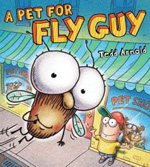 Fans of the earlier books featuring Buzz and his friend Fly Guy are sure to enjoy this one a great deal. After all, what human wouldn’t love to have a fly for his companion? As best friends do, the two spend time together each day, playing games, hanging out, and watching others. But the fly in the ointment comes when Buzz decides that Fly Guy needs a pet of his own. The two valiantly search for the perfect pet, but they have little success. A puppy licks him, a kitty swipes at him, and a frog chases him. Eventually, Fly Guy realizes that the right pet has been there all along—Buzz. Together, the two walk off into the sunset, arguing about who is the best pet. The book’s last page with its repeated argument and shrinking illustrations is particularly appealing and sums up the relationship between a boy and his fly. The digital illustrations created using Photoshop really make Buzz and Fly Guy come alive.
Fans of the earlier books featuring Buzz and his friend Fly Guy are sure to enjoy this one a great deal. After all, what human wouldn’t love to have a fly for his companion? As best friends do, the two spend time together each day, playing games, hanging out, and watching others. But the fly in the ointment comes when Buzz decides that Fly Guy needs a pet of his own. The two valiantly search for the perfect pet, but they have little success. A puppy licks him, a kitty swipes at him, and a frog chases him. Eventually, Fly Guy realizes that the right pet has been there all along—Buzz. Together, the two walk off into the sunset, arguing about who is the best pet. The book’s last page with its repeated argument and shrinking illustrations is particularly appealing and sums up the relationship between a boy and his fly. The digital illustrations created using Photoshop really make Buzz and Fly Guy come alive.
- Barbara A. Ward, Washington State University Pullman
Flory, Neil. (2014). The short giraffe. Illus. by Mark Cleary. Park Ridge, IL: Albert Whitman & Company.
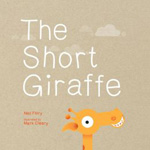 All the other giraffes are so very tall compared to diminutive Geri that taking a group picture poses a problem. After considering several ways for Geri to rise to their heights without much success, the giraffes finally listen to the suggestion of a wise caterpillar, and they make the right move that allows her to be included comfortably in the photograph. The text and the soft colors in this picture book are gentle reminder that sometimes we need to bend a little bit to accommodate the needs of others and that being different, even in stature, is not necessarily a bad thing.
All the other giraffes are so very tall compared to diminutive Geri that taking a group picture poses a problem. After considering several ways for Geri to rise to their heights without much success, the giraffes finally listen to the suggestion of a wise caterpillar, and they make the right move that allows her to be included comfortably in the photograph. The text and the soft colors in this picture book are gentle reminder that sometimes we need to bend a little bit to accommodate the needs of others and that being different, even in stature, is not necessarily a bad thing.
- Barbara A. Ward, Washington State University Pullman
Graves, Keith. (2014). Chicken Big. San Francisco, CA: Chronicle Books.
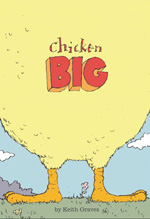 When an enormous egg hatches into a very large chick, all the other chickens are convinced that this larger than normal chick cannot possibly be a chicken. They misidentify him as a squirrel, a sweater, and even an umbrella because of his actions. But after he rescues the eggs stolen by a fox, the chickens decide that he is simply a very, very large chicken, and they’re glad to have him around. Created with pencils and pixels, the illustrations are lively and will keep readers engaged. This is a wonderfully delightful read aloud title, filled with humorous details and witty observations about the intelligence of the chickens who make plenty of assumptions based on what they are observing about that big chick.
When an enormous egg hatches into a very large chick, all the other chickens are convinced that this larger than normal chick cannot possibly be a chicken. They misidentify him as a squirrel, a sweater, and even an umbrella because of his actions. But after he rescues the eggs stolen by a fox, the chickens decide that he is simply a very, very large chicken, and they’re glad to have him around. Created with pencils and pixels, the illustrations are lively and will keep readers engaged. This is a wonderfully delightful read aloud title, filled with humorous details and witty observations about the intelligence of the chickens who make plenty of assumptions based on what they are observing about that big chick.
- Barbara A. Ward, Washington State University Pullman
Krensky, Stephen. (2014). I am so brave! Illus. by Sara Gillingham. New York, NY: Abrams/Abrams Appleseed.
 Part of the Abrams Appleseed series on empowerment, this title describes various situations that might cause a youngster to feel anxious. The facing page reveals how fears about something in particular may be eased by trying something new. The appealing illustrations are bright and simple. One of the elements that is most appealing involves how the little boy in the illustrations always seems to have something nearby to provide reassurance. For instance, his mother or a stuffed animal provide quiet support as he works through his fears.
Part of the Abrams Appleseed series on empowerment, this title describes various situations that might cause a youngster to feel anxious. The facing page reveals how fears about something in particular may be eased by trying something new. The appealing illustrations are bright and simple. One of the elements that is most appealing involves how the little boy in the illustrations always seems to have something nearby to provide reassurance. For instance, his mother or a stuffed animal provide quiet support as he works through his fears.
- Barbara A. Ward, Washington State University Pullman
Murguia, Bethanie Deenie. (2014). Zoe’s jungle. New York, NY: Scholastic.
 Imaginative Zoe and her sister Addie don’t waste any chance to play, and when their mother pauses at a playground on their way to story time, they make the most of their opportunity to explore. They quickly begin—or continue—a game of chase in which Zoe is a renowned explorer and Addie is a stealthy beast eluding her grasp in the jungle of the playground. Young readers will relate to the move from reality to fantasy through Zoe’s imagination of how the adventure is occurring and her mother's calls to come now. Paying tribute to the imagination of children, the text and pen-and-ink and watercolor illustrations showing the beast Addie turns into are lively and appealing. Clearly, Zoe is a born storyteller with many adventures in her future.
Imaginative Zoe and her sister Addie don’t waste any chance to play, and when their mother pauses at a playground on their way to story time, they make the most of their opportunity to explore. They quickly begin—or continue—a game of chase in which Zoe is a renowned explorer and Addie is a stealthy beast eluding her grasp in the jungle of the playground. Young readers will relate to the move from reality to fantasy through Zoe’s imagination of how the adventure is occurring and her mother's calls to come now. Paying tribute to the imagination of children, the text and pen-and-ink and watercolor illustrations showing the beast Addie turns into are lively and appealing. Clearly, Zoe is a born storyteller with many adventures in her future.
- Barbara A. Ward, Washington State University Pullman
Grades 4–6
Martin, Ann. M. (2014). Family tree: Best kept secret. New York, NY: Scholastic Press.
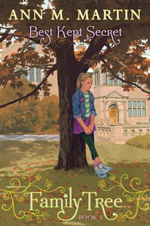 The family at the heart of the Family Tree series is a lot like most families. They have their struggles and successes, and they have secrets that they keep. The third title focuses on Dana's daughter Francie, who has a comfortable life despite the challenges with reading caused by her dyslexia. She loves her Princeton, New Jersey, home and has supportive parents and friends. When a stranger almost lures her into his car to see his puppy and later, another neighbor girl disappears, Francie is convinced that her keeping the occurrence a secret resulted in the girl's likely death and that her parents will blame her. The secret changes her, making her less trusting and even more secretive. As her family dynamics change due to births, deaths, and new relationships, Francie continues to excel as a writer. Fans of this series will appreciate the insight that perspective brings on events from the previous books; for instance, it is now easier to understand how Dana's decision to move to New York and live with her aunt Adele affected her mother, Abby. The author spends most of her time on Francie’s formative years, only briefly touching on her move to college. This series is charming and provides insight into its characters and the times in which they are growing up.
The family at the heart of the Family Tree series is a lot like most families. They have their struggles and successes, and they have secrets that they keep. The third title focuses on Dana's daughter Francie, who has a comfortable life despite the challenges with reading caused by her dyslexia. She loves her Princeton, New Jersey, home and has supportive parents and friends. When a stranger almost lures her into his car to see his puppy and later, another neighbor girl disappears, Francie is convinced that her keeping the occurrence a secret resulted in the girl's likely death and that her parents will blame her. The secret changes her, making her less trusting and even more secretive. As her family dynamics change due to births, deaths, and new relationships, Francie continues to excel as a writer. Fans of this series will appreciate the insight that perspective brings on events from the previous books; for instance, it is now easier to understand how Dana's decision to move to New York and live with her aunt Adele affected her mother, Abby. The author spends most of her time on Francie’s formative years, only briefly touching on her move to college. This series is charming and provides insight into its characters and the times in which they are growing up.
- Barbara A. Ward, Washington State University Pullman
Mlynowski, Sarah. (2014). Whatever after: Bad hair day. New York, NY: Scholastic Press.
 It's hard not to fall happily ever after in love with the Whatever After series with its deft blending of the modern world and the world of fairy tales. In this, the fifth title in the series, fifth grader Abby and her younger brother Jonah travel through the looking glass in their basement and into the well-known fairy tale featuring she of the long locks of hair perfect for climbing—Rapunzel. As usual, they must take care not to make too many changes during their visit or else the fairy tale itself will be forever changed. This Rapunzel is practically paralyzed with low self-esteem. She is convinced that the only positive thing about herself is her abundant locks, and when Jonah inadvertently ruins those, Rapunzel is distraught. Things go from bad to worse when Abby trims her hair. The shorter cut does not suit Rapunzel, and she is furious about having what little she had going for her ruined. When the two siblings finally coax Rapunzel from her tower, she is disappointed in the real world and prefers returning to her tower prison. The book contains a positive message for all readers since both Abby and Rapunzel realize that self-esteem should not be measured by how well one does a particular task or one aspect about oneself. With all the fairy tales available to her, this author should keep fracturing more of them, using her own trademark humor and proving that fairy tales are just as relevant today as when they were first written.
It's hard not to fall happily ever after in love with the Whatever After series with its deft blending of the modern world and the world of fairy tales. In this, the fifth title in the series, fifth grader Abby and her younger brother Jonah travel through the looking glass in their basement and into the well-known fairy tale featuring she of the long locks of hair perfect for climbing—Rapunzel. As usual, they must take care not to make too many changes during their visit or else the fairy tale itself will be forever changed. This Rapunzel is practically paralyzed with low self-esteem. She is convinced that the only positive thing about herself is her abundant locks, and when Jonah inadvertently ruins those, Rapunzel is distraught. Things go from bad to worse when Abby trims her hair. The shorter cut does not suit Rapunzel, and she is furious about having what little she had going for her ruined. When the two siblings finally coax Rapunzel from her tower, she is disappointed in the real world and prefers returning to her tower prison. The book contains a positive message for all readers since both Abby and Rapunzel realize that self-esteem should not be measured by how well one does a particular task or one aspect about oneself. With all the fairy tales available to her, this author should keep fracturing more of them, using her own trademark humor and proving that fairy tales are just as relevant today as when they were first written.
- Barbara A. Ward, Washington State University Pullman
Grades 7–8
Harrington, Karen. (2014). Courage for beginners. New York, NY: Little, Brown Books for Young Readers.
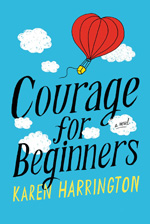 Seventh-grader Mysti Murphy wishes that life were as predictable as the books she loves to read. Maybe then she would be able to figure out what to do and how to handle life’s challenges. Not only is her mother severely agoraphobic and her father in the hospital with a head injury, but her best friend Anibal Gomez has deserted her. As part of his bid to become popular and change his image, he ignores Mysti and makes her the butt of a series of jokes while remaining secret friends. Were it not for the friendship offered by Rama Khan [Mysti thinks of her as Girl with Scarf], school would be even worse for Mysti. But Mysti's main concerns revolve around the situation at home. Since her mother refuses to leave the house to get groceries or ask for the help of others, the family's food supply dwindles, and they are subsisting on meager sustenance. Even her dog Larry is losing weight. Can Mysti find the courage to take the risks her own mother cannot? Readers will fall in love with the quirky yet charming girl and root for her to make the changes she needs to make in order to take charge of her life. Acts of bravery happen, step by step, and risk by risk. This is another winner by the author of Sure Signs of Crazy (Little Brown Books for Children, 2013).
Seventh-grader Mysti Murphy wishes that life were as predictable as the books she loves to read. Maybe then she would be able to figure out what to do and how to handle life’s challenges. Not only is her mother severely agoraphobic and her father in the hospital with a head injury, but her best friend Anibal Gomez has deserted her. As part of his bid to become popular and change his image, he ignores Mysti and makes her the butt of a series of jokes while remaining secret friends. Were it not for the friendship offered by Rama Khan [Mysti thinks of her as Girl with Scarf], school would be even worse for Mysti. But Mysti's main concerns revolve around the situation at home. Since her mother refuses to leave the house to get groceries or ask for the help of others, the family's food supply dwindles, and they are subsisting on meager sustenance. Even her dog Larry is losing weight. Can Mysti find the courage to take the risks her own mother cannot? Readers will fall in love with the quirky yet charming girl and root for her to make the changes she needs to make in order to take charge of her life. Acts of bravery happen, step by step, and risk by risk. This is another winner by the author of Sure Signs of Crazy (Little Brown Books for Children, 2013).
- Barbara A. Ward, Washington State University Pullman
Tashjian, Janet. (2014). My life as a joke. Illus. by Jake Tashjian. New York, NY: Henry Holt & Company.
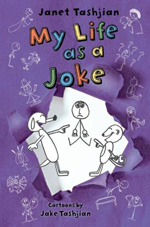 Twelve-year-old Derek Fallon is determined to make this year different. His goal is to make sure that his classmates take him seriously. But the best laid plans of twelve-year-olds don't always turn out the way they might hope, and through a series of mishaps, Derek ends up being viewed as something of a joke. Even his delight at being invited to a cool new neighbor's party wanes once he realizes he was invited, not as a guest but as a babysitter for the host's younger sibling. As he moves from misstep to misstep, Derek finds some satisfaction in collecting donations for other children. But he somehow manages to make a big mistake doing so. Even when he messes up that community service project, he figures a way to atone for his mistakes, earning a better reward than he could ever have imagined. Like its predecessors, this series tackles many issues faced by middle graders, prompting them to consider their actions, their consequences, and their own culpability. Readers will also enjoy the illustrations of words provided by the author's son. Fans of the Diary of a Wimpy Kid series are likely to enjoy this one partly because of its humorous elements, but also because it is honest in its treatment of family dynamics and school.
Twelve-year-old Derek Fallon is determined to make this year different. His goal is to make sure that his classmates take him seriously. But the best laid plans of twelve-year-olds don't always turn out the way they might hope, and through a series of mishaps, Derek ends up being viewed as something of a joke. Even his delight at being invited to a cool new neighbor's party wanes once he realizes he was invited, not as a guest but as a babysitter for the host's younger sibling. As he moves from misstep to misstep, Derek finds some satisfaction in collecting donations for other children. But he somehow manages to make a big mistake doing so. Even when he messes up that community service project, he figures a way to atone for his mistakes, earning a better reward than he could ever have imagined. Like its predecessors, this series tackles many issues faced by middle graders, prompting them to consider their actions, their consequences, and their own culpability. Readers will also enjoy the illustrations of words provided by the author's son. Fans of the Diary of a Wimpy Kid series are likely to enjoy this one partly because of its humorous elements, but also because it is honest in its treatment of family dynamics and school.
- Barbara A. Ward, Washington State University Pullman
Grades 9–12
Cotugno, Katie. (2013). How to love. New York, NY: HarperCollins/Balzer + Bray.
 Many readers may have had the experience of falling helplessly and hopelessly in love with the guy of their dreams only to have him disappear, and then, after working hard to heal that broken heart, have him reappear once again. While it might be hoped that the connection is gone, in the case of Reena Montero, this book's protagonist, the connection is still very much alive. Reena has never really believed that she was good enough for Sawyer LeGrande or that she was his type when the truth is a lot more complicated than that. The author alternates Before and After chapters describing how Reena first fell for Sawyer, and then detailing what happens once he returns after a two year absence. As a high school teen, Reena had ambitions of leaving her Florida town and traveling the world, but when she becomes pregnant, her priorities change. The rocky romance takes all sorts of twists and turns, and it isn't clear that things will work out in the end, but teen readers will come to care deeply about Reena and Sawyer. Many readers may ponder the ineffable power of mutual attraction and why, oh, why, so many women are attracted to the wrong kinds of men. As a side note, it bears mentioning that Reena's best friend Shelby is particularly noteworthy for her own honesty and loyalty to Reena even while Reena’s first best friend Allie forsakes Reena once a cooler crowd takes her in. It can be hard to keep your own footing when those around you are losing theirs.
Many readers may have had the experience of falling helplessly and hopelessly in love with the guy of their dreams only to have him disappear, and then, after working hard to heal that broken heart, have him reappear once again. While it might be hoped that the connection is gone, in the case of Reena Montero, this book's protagonist, the connection is still very much alive. Reena has never really believed that she was good enough for Sawyer LeGrande or that she was his type when the truth is a lot more complicated than that. The author alternates Before and After chapters describing how Reena first fell for Sawyer, and then detailing what happens once he returns after a two year absence. As a high school teen, Reena had ambitions of leaving her Florida town and traveling the world, but when she becomes pregnant, her priorities change. The rocky romance takes all sorts of twists and turns, and it isn't clear that things will work out in the end, but teen readers will come to care deeply about Reena and Sawyer. Many readers may ponder the ineffable power of mutual attraction and why, oh, why, so many women are attracted to the wrong kinds of men. As a side note, it bears mentioning that Reena's best friend Shelby is particularly noteworthy for her own honesty and loyalty to Reena even while Reena’s first best friend Allie forsakes Reena once a cooler crowd takes her in. It can be hard to keep your own footing when those around you are losing theirs.
- Barbara A. Ward, Washington State University Pullman
Giles, Gail. (2014). Girls like us. Somerville, MA: Candlewick Press.
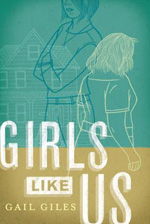 This book follows Biddy and Quincy, two teens with their own particular challenges or dysfunctions, after their graduation. As students, their school mates called them "Speddies" because they received special services. Upon graduation, the two share an apartment and given jobs that draw on their particular strengths. But both keep parts of themselves hidden and have secrets that begin to be revealed over time. Because the book alternates between the two voices, readers are able to eavesdrop on both girls' fears as well as notice how they are changing and growing stronger and more confident. While many might think that girls like the two of them don't matter, the truth is that their stories and their resiliency against almost impossible odds is worth celebrating. Although things are resolved in a satisfactory fashion, the book does not end with the surety of everyone living happily ever after. But at least readers are reminded that these two count just as much as their more affluent counterparts. This book is brimming with truth, some of it painfully unpalatable and some of it worth repeating. The truth of the matter is that much of life is not fair, and it isn't easy to bloom where you are planted. A little bit of nurturing can go a long, long way, though.
This book follows Biddy and Quincy, two teens with their own particular challenges or dysfunctions, after their graduation. As students, their school mates called them "Speddies" because they received special services. Upon graduation, the two share an apartment and given jobs that draw on their particular strengths. But both keep parts of themselves hidden and have secrets that begin to be revealed over time. Because the book alternates between the two voices, readers are able to eavesdrop on both girls' fears as well as notice how they are changing and growing stronger and more confident. While many might think that girls like the two of them don't matter, the truth is that their stories and their resiliency against almost impossible odds is worth celebrating. Although things are resolved in a satisfactory fashion, the book does not end with the surety of everyone living happily ever after. But at least readers are reminded that these two count just as much as their more affluent counterparts. This book is brimming with truth, some of it painfully unpalatable and some of it worth repeating. The truth of the matter is that much of life is not fair, and it isn't easy to bloom where you are planted. A little bit of nurturing can go a long, long way, though.
- Barbara A. Ward, Washington State University Pullman
Nelson, Blake. (2014). The prince of Venice Beach. New York, NY: Little, Brown Books for Young Readers.
 Nebraska is far behind Robert (Cali) Callahan now that he lives in Venice Beach, California. Although he is practically homeless, Cali has a lot more going for him than most teens on the local streets. After all, he has a tree house where he sleeps, and because he knows the streets and its inhabitants pretty well, others trust him. Then, too, Cali dreams of possibly becoming a private investigator and even keeps a self-improvement list. Although he has some success and makes some money, ethical questions assail him. When he meets Reese Abernathy, another troubled runaway, he isn't sure how much of her story to believe. The author does a marvelous job of portraying Cali and his gullibility. Readers will race through this page-turner with its in-depth character study to see what happens to Cali, Reese, and Ailis, Cali's business partner and possible romantic interest. Because the large and small tragedies of the lives of these individuals are only hinted at, they seem even more complex than they would otherwise. Readers will miss the ambitious Cali’s noble spirit, princely ways, and desire to help others.
Nebraska is far behind Robert (Cali) Callahan now that he lives in Venice Beach, California. Although he is practically homeless, Cali has a lot more going for him than most teens on the local streets. After all, he has a tree house where he sleeps, and because he knows the streets and its inhabitants pretty well, others trust him. Then, too, Cali dreams of possibly becoming a private investigator and even keeps a self-improvement list. Although he has some success and makes some money, ethical questions assail him. When he meets Reese Abernathy, another troubled runaway, he isn't sure how much of her story to believe. The author does a marvelous job of portraying Cali and his gullibility. Readers will race through this page-turner with its in-depth character study to see what happens to Cali, Reese, and Ailis, Cali's business partner and possible romantic interest. Because the large and small tragedies of the lives of these individuals are only hinted at, they seem even more complex than they would otherwise. Readers will miss the ambitious Cali’s noble spirit, princely ways, and desire to help others.
- Barbara A. Ward, Washington State University Pullman
Smith, Jennifer E. (2014). The geography of you and me. New York, NY: Little, Brown/Poppy.
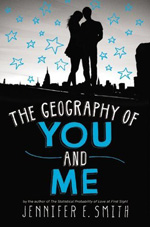 Although this is familiar territory—boy and girl from different socioeconomic classes meet, spend time together and form a bond that might lead to something more but alas, they go their different ways—readers will enjoy thinking about the possibilities of love and the mysteries of the universe that make love stay or go. When a citywide blackout in New York City causes the elevator in which Owen and Lucy are riding to stop, they strike up a conversation, and against all odds, end up exploring the city and the stars from the building's rooftop. Both feel a strong connection and sense of possibility, but circumstances prevent anything further happening. They agree to keep in touch through postcards, something of a private joke about wishing the addressee were with the sender. Circumstances take Lucy to Europe and Owen across the United States, moving ever-westward. Both meet other possible love interests, and their parents move from job to job, city to city, increasing the physical distance but perhaps not the emotional distance. Naysayers will list all the reasons that long distance relationships won't work, but this book provides some arguments about how theirs just might.
Although this is familiar territory—boy and girl from different socioeconomic classes meet, spend time together and form a bond that might lead to something more but alas, they go their different ways—readers will enjoy thinking about the possibilities of love and the mysteries of the universe that make love stay or go. When a citywide blackout in New York City causes the elevator in which Owen and Lucy are riding to stop, they strike up a conversation, and against all odds, end up exploring the city and the stars from the building's rooftop. Both feel a strong connection and sense of possibility, but circumstances prevent anything further happening. They agree to keep in touch through postcards, something of a private joke about wishing the addressee were with the sender. Circumstances take Lucy to Europe and Owen across the United States, moving ever-westward. Both meet other possible love interests, and their parents move from job to job, city to city, increasing the physical distance but perhaps not the emotional distance. Naysayers will list all the reasons that long distance relationships won't work, but this book provides some arguments about how theirs just might.
- Barbara A. Ward, Washington State University Pullman
These reviews and resources are submitted by members of the International Reading Association’s Children’s Literature and Special Interest Group (CL/R SIG) and are published weekly on Reading Today Online.